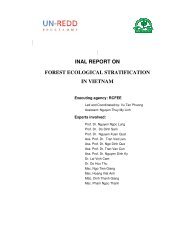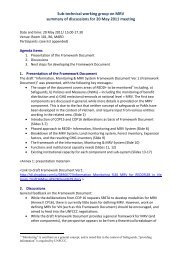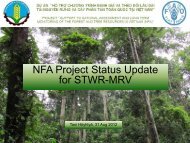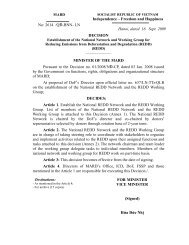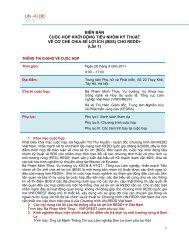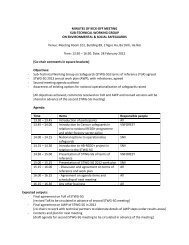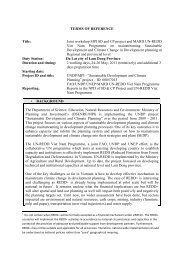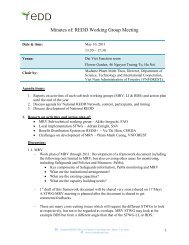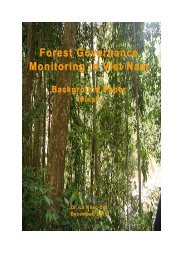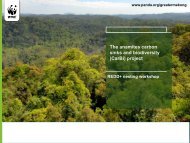Decision No. 3119/QD-BNN-KHCN.pdf - REDD - VietNam
Decision No. 3119/QD-BNN-KHCN.pdf - REDD - VietNam
Decision No. 3119/QD-BNN-KHCN.pdf - REDD - VietNam
Create successful ePaper yourself
Turn your PDF publications into a flip-book with our unique Google optimized e-Paper software.
MINISTRY OF AGRICULTURE SOCIALIST REPUBLIC OF VIETNAM<br />
AND RURAL DEVELOPMENT Independence- Freedom-Happiness<br />
–––––––––––––<br />
––––––––––––––––––––––<br />
<strong>No</strong>: <strong>3119</strong> /<strong>QD</strong>-<strong>BNN</strong>-<strong>KHCN</strong> Hanoi, date on 16 Dec. 2011<br />
DECISION<br />
On approving programme of Green House Gas (GHG) emissions reduction in<br />
the Agriculture and Rural Development sector up to 2020<br />
––––––––––––––––––––––––––––<br />
MINISTER OF AGRICULTURE AND RURAL DEVELOPMENT<br />
Based on Decree N o 01/2008/ND-CP issued on 03/01/2008 by the Prime<br />
Minister to regulate functions, tasks and organizing pattern of the Ministry of<br />
Agriculture and Rural Development and Decree <strong>No</strong> 75/2009/NĐ-CP issued on<br />
10/9/2009 by the Prime Minister to correct the Article 3 of Decree <strong>No</strong> 01/2008/ND-<br />
CP;<br />
Based on <strong>Decision</strong> N o 1410/QĐ-TTg issued on 16/8/2011 by the Prime<br />
Minister approving the framework of third cycle policy matrix in 2011 under the<br />
Support Program to Respond to Climate Change (SP-RCC);<br />
Based on <strong>Decision</strong> N o 543/QĐ-<strong>BNN</strong>-<strong>KHCN</strong> issued on 23/3/2011 by the<br />
Minister of MARD approving the action plan to respond to climate change in the<br />
agriculture and rural development sector in the period 2011-2015 and vision to 2020;<br />
Based on <strong>Decision</strong> N o 2081/QĐ-<strong>BNN</strong>-<strong>KHCN</strong> issued on 9/9/2011 by the<br />
Minister of Agriculture and Rural Development assigning responsibilities to<br />
implement the Support Program to Respond to Climate Change (SP-RCC);<br />
According to proposal by the Director General of the Department of Science,<br />
Technology and Environment,<br />
DECISION<br />
Article 1. Approving the programme of greenhouse gas (GHG) emission<br />
reduction in the agriculture and rural development sector up to 2020 with the<br />
following details:<br />
1. Main of viewpoints<br />
The integrated solutions of GHG emission reduction in agriculture and rural<br />
development sector needs:<br />
- To satisfy the purposes of economic growth, food security assurance,<br />
industrialization and modernization in agriculture and rural areas, environmental<br />
protection and making a significant contribution to responding to climate change;
- To ensure the simplest, the most practical, obtain high socioeconomic and<br />
environmental effectiveness and to not cause disorder of agricultural and rural<br />
activities;<br />
- To be able to expand, socialize and mobilize the various stakeholders’ high<br />
potential to participate in carbon market to sustainably raise funds for emission<br />
reduction activities in agriculture and rural development;<br />
- GHG emission reduction activities are high priority in sustainable agriculture<br />
development, it is not only national voluntary efforts but also needs active supports<br />
from the international community.<br />
2. Objectives<br />
- To promote green and safe agricultural production to produce, low emissions,<br />
sustainable development and ensuring national food security, contributing to poverty<br />
reduction and effectively responding to climate change;<br />
- Up to 2020, to reduce by 20% the total GHG emission in agriculture and rural<br />
development sector (18.87 million ton CO 2 e); and simultaneously ensure the growth<br />
target of agriculture and rural development, and reduce the poverty rate according to<br />
sectoral development strategy;<br />
3. Tasks<br />
The main activities to reduce GHG emission in the agriculture and rural<br />
development sector include:<br />
3.1. Crop production<br />
3.1.1. Main activities<br />
To reduce 5.72 million ton CO 2 e (equivalent to 10.03% of the forecast<br />
emissions from the crop production sector up to 2020), the following main activities<br />
will be implemented:<br />
1. Apply improved cultivation techniques on rice production such as water<br />
irrigation and inputs saving (including system of rice intensification (SRI), three<br />
reduction and three gains (3G3T), one obligations and five reduction (1P5G),<br />
alternate wetting and drying (AWD),…) to reduce GHG emissions;<br />
- Scale: 3.2 million ha of rice cultivation areas to apply SRI, 3G3T, 1P5G,<br />
AWD up to 2020;<br />
- Implementing location: active irrigated rice area, priority areas for intensive<br />
rice production (the Red River Delta (RRD), <strong>No</strong>rth Central Coastal (NCC) and the<br />
Mekong River Delta (MRD));<br />
- Potential of GHG emission reduction: 4.18 million ton of CO 2 e (equivalent to<br />
7.33% of the total forecast GHG emission in the crop production sector up to 2020);<br />
2
2. Collect and reuse rice straw to completely restrict its burnings and burying<br />
which increase GHG emission and environmental pollution;<br />
- Scale: 100% of rice cultivated areas, approximate 7 million hectare of rice;<br />
- Implementing location: main rice intensive regions;<br />
- Potential of GHG emission reduction: 1.54 million ton of CO 2 e (equivalent to<br />
2.70% of the forecast total GHG emissions from the crop production sector up to<br />
2020);<br />
3.1.2. Other activities to support GHG emission reduction in crop production<br />
are encouraged:<br />
1. Apply technical solutions to enhance effectives of nitrogen fertilizers to<br />
reduce N 2 O emissions from paddy cultivation and other crops;<br />
2. Transform a part of rice cultivation areas with low outputs to short duration<br />
industrial crops with low emission and higher economic revenue;<br />
3. Transform one rice crop from land with 2-3 three rice harvests with low<br />
outputs along the rivers and seashore to aquaculture (shrimp, fish) to obtain higher<br />
economic value;<br />
4. Apply solutions to save energy and fuel in land preparation, irrigation for<br />
industrial crops, develop and apply minimum tillage to reduce GHG emissions;<br />
5. Develop and apply technology to treat and reuse crop residues from<br />
vegetable production, short duration and perennial industrial crops, sugar cane to<br />
reduce GHG emission from crop residue disintegration.<br />
3.2. Livestock<br />
3.2.1. Main activities<br />
To reduce 6.30 million ton of CO 2 e (equivalent to 25.84% of total forecasted<br />
GHG emission in the livestock sector up to 2020), the following main activities<br />
should be implemented:<br />
1. Change the feed portions for animal and poultry raising to reduce GHG<br />
emission from livestock activities:<br />
- Scale: 30% of total processed feed, equal to 3.5 million ton of feed;<br />
- Implementing location: intensive animal raising regions are priority;<br />
- Potential of GHG emission reduction: 0.91 million ton of CO 2 e (equivalent to<br />
3.73% of total forecast GHG emission from the livestock sector up to 2020).<br />
2. Provide Molasses Urea Blocks (MUBs) as milk cow feed to reduce GHG<br />
emissions.<br />
- Scale: 192,000 milk cows<br />
- Implementing location: milk cow raising regions.<br />
3
- Potential of GHG emission reduction: 0.37 million ton of CO 2 e (equal to<br />
1.51% of total forecasted GHG emission from livestock sector up to 2020).<br />
fuel:<br />
3. Apply biogas to treat animal wastes and produce bio-fuel to replace fossil<br />
- Scale: 500,000 biogas installations including underground tanks;<br />
- Implementing location: all regions, especially in the high intensive animal<br />
raising areas.<br />
- Potential of GHG emissions reduction: 1.46 million ton of CO 2 e (equivalent<br />
to 5.99% of total forecasted GHG emission from livestock sector up to 2020).<br />
4. Applying the compost technology to treat animal and poultry waste to reduce<br />
GHG emission.<br />
- Scale: 40 million ton of animal and poultry wastes (including 20 million ton<br />
waste from pig raising and 20 million ton from poultry raising).<br />
- Implementing location: animal and poultry raising households, especially in<br />
pig raising households;<br />
- Potential of GHG emission reduction: 3.56 million ton of CO 2 e (equal to<br />
14.6% of total forecasted GHG emissions from the livestock sector up to 2020).<br />
3.2.2. Other activities are:<br />
1. Apply the VietGAP model (good agricultural practices) in livestock<br />
production<br />
2. Replace partly raw foods by purified food and enhance quality of fermented<br />
feed for livestock production;<br />
3. Enhance the immunity and biological control for animal and poultry<br />
production;<br />
4. Apply and use antibiotic bacteria and intestine bacteria to reduce GHG<br />
emissions from livestock production;<br />
5. Improve waste collection system in cattle barns, systems of storing and treat<br />
animal wastes.<br />
3.3. Forestry<br />
3.3.1. Main activities<br />
To increase carbon sequestration and reduce GHG emissions in the forestry<br />
sector, the following main activities should be taken:<br />
1. Strengthen forestry plantation, restore forestry, reforest, and enrich forest in<br />
planned areas according to the forestry development strategy for the period 2010 –<br />
2020:<br />
- Scale: 2.6 million hectares plantation forest;<br />
4
- Implementing location: forestry areas across the country<br />
- Potential of GHG emissions reduction: sequestration of 702 million ton CO 2 e.<br />
2. Protect, develop and sustainably use forest to increase carbon sequestration<br />
and eliminate GHG emission from forestry:<br />
- Scale: 13.8 million hectares<br />
- Implementing location: forest areas across the country.<br />
- Potential of GHG emission reduction: sequestration of 669 million ton of<br />
CO 2 e;<br />
3.3.2. Other activities are:<br />
1. Strengthen communication campaign and capacity building on awareness to<br />
protect and sustainable forest utilization, forest fire prevention;<br />
2. Strengthen international collaboration to promote carbon-credit market in<br />
forestry sector.<br />
3.4. Fisheries<br />
3.4.1. Main activities<br />
To reduce GHG emissions from fisheries by 3 million ton CO 2 e (equivalent to<br />
23.32% of total forecasted GHG emissions from the fishery sector up to 2020), the<br />
following main activities should be implemented:<br />
1. Adjust the unsuitable capacity of fishing boats with fishing ground; re-plan<br />
fishing routines and determine optimal regions to reduce GHG emission from fishing<br />
activities:<br />
- Scale: stable maintain from 15,000-18,000 fishing boats.<br />
- Implementing location: off shore fishing grounds and new fishing grounds<br />
- Potential of GHG emission reduction: 0.69 million ton of CO 2 e (about 5.32%<br />
of total forecasted GHG emission in the fishery sector up to 2020)<br />
2. Improve fishing technique and technologies in fishing activities to reduce<br />
GHG emission:<br />
- Scale: off shore fishing grounds.<br />
- Implementing location: off shore fishing boats and new fishing grounds<br />
- Potential of GHG emission reduction: 0.48 million ton of CO 2 e (about 3.72%<br />
of total forecasted GHG emission in the fishery sector up to 2020).<br />
3. Establish and improve models of fishing services, protect fishing grounds to<br />
reduce GHG emission because of fuel savings:<br />
- Scale: off shore fishing grounds<br />
- Implementing location: off shore fishing grounds and new fishing grounds<br />
5
- Potential of GHG emission reduction: 0.21 million ton of CO 2 e (about 1.59%<br />
of total forecasted GHG emission in the fishery sector up to 2020).<br />
4. Renew offering services for aquaculture such as fish varieties, feed,<br />
medicine, chemical, fertilizer and equipment supplies to reduce GHG emissions.<br />
- Scale: key aquacultural regions<br />
- Implementing location: Mekong River Delta, South East, Central Coastal and<br />
Red River Delta regions;<br />
- Potential of GHG emission reduction: 0.41 million ton of CO 2 e (about 3.17%<br />
of total forecasted GHG emission in the fishery sector up to 2020).<br />
5. Improve aquacultural technologies, techniques and waste management from<br />
aquaculture to reduce GHG emissions:<br />
- Scale: 50% of aquacultural areas (equivalent to 0.55 million hectare).<br />
- Implementing location: Mekong River Delta, South East, Central Coastal and<br />
Red River Delta Regions;<br />
- Potential of GHG emission reduction: 1.21 million ton of CO 2 e (about 9.52%<br />
of total forecasted GHG emissions in the fishery sector up to 2020).<br />
3.4.2. Other activities are:<br />
1. Enhance carbon, nitrogen sequestration and cycles through effective waste<br />
management, and development of models and suitable new practices;<br />
2. Improve cold storage system to save fossil fuels to reduce GHG emission<br />
from fishing activities;<br />
3. Improve and select suitable fishing equipments to enhance fishing capacity;<br />
fix boundary of fishing ground to reduce moving distance in fishing activities.<br />
3.5. Irrigation<br />
3.5.1. Main activities<br />
To reduce 0.17 million ton of CO 2 e from irrigation activities (about 20% of<br />
total forecasted GHG emission from irrigation activities up to 2020), the following<br />
main activities should be taken:<br />
1. Enhance effectiveness of irrigated pumping system to save energy and<br />
reduce GHG emissions.<br />
- Scale: saving 100MWh of electricity for 10,000 water pumping stations<br />
- Implementing location: regions irrigated by water pumping systems for rice<br />
cultivation<br />
- Potential of GHG emission reduction: 0.075 million ton of CO e 2 (about 9%<br />
of total forecasted GHG emission in irrigation sector up to 2020).<br />
6
2. Enhance effectiveness of drained pumping system to save energy and reduce<br />
GHG emission.<br />
- Scale: saving 120MWh of electricity for 10,000 water pumping stations<br />
- Implementing location: regions drained by water pumping stations to<br />
cultivate rice<br />
Potential of GHG emission reduction: 0.095 million ton of CO 2 e (about 11% of<br />
total forecasted GHG emission in the irrigation sector up to 2020).<br />
3.5.2. Other activities are:<br />
1. Improve irrigated systems to prevent water losses and effectively manage<br />
and stabilize irrigation systems and explore autonomous water running system to and<br />
reduce losses and save irrigated water.<br />
2. Effectively exploit and reservoirs and clean reservoirs before storing water<br />
in reservoirs.<br />
3. Apply new technologies and equipment in constructing irrigation and<br />
drainage systems to save energy.<br />
3.6. Rural activities and occupations:<br />
3.6.1. Main activities<br />
To reduce GHG emissions in villages and the and rural artisanal sector by 4.78<br />
million ton of CO 2 e (about 24.7% total forecasted GHG emissions from the villages<br />
and the rural artisanal sector up to 2020), the following main activities should be<br />
implemented:<br />
1. Applying suitable models to collect and treat waste from human and<br />
artisenal activities in rural areas:<br />
- Scale: completely treat about 50% total rural solid waste, equivalent to 12.51<br />
million ton.<br />
- Implementing location: high population density rural centres in the Red River<br />
Delta, South East and Mekong River Delta Regions;<br />
- Potential of GHG emissions reduction: 1.87 million ton of CO 2 e (about 9.7%<br />
of total forecasted GHG emissions in the rural sector up to 2020).<br />
2. Partly change cooking fuel from coal and charcoal and firewood to biofuels<br />
and gas with low GHG emissions.<br />
- Scale: 50% cooking fuel proportion in rural area, equal to 0.48 million ton oil<br />
equivalent (tOe)<br />
- Implementing location: priority for high population density rural areas,<br />
livestock production areas.<br />
7
- Potential of GHG emission reduction: 0.61 million ton of CO 2 e (about 3.2%<br />
of total forecasted GHG emissions in the rural sector up to 2020).<br />
3. Enhance energy saving practices from activities<br />
- Scale: saving 20% electricity consumption in rural areas, equal to 3.06<br />
million MWh.<br />
- Implementing location: high population density rural areas, artisanal villages;<br />
- Potential of GHG emission reduction: reducing 2.3 million ton of CO 2 e<br />
(about 11.8% of total forecasted GHG emissions in rural activities and artisanal<br />
villages up to 2020).<br />
3.6.2. Other activities are:<br />
1. Saving electricity consumption from handicraft production and processing<br />
activities.<br />
2. Develop and apply suitable equipment to use energy efficiently, bio-fuel,<br />
solar and other forms of renewable energy.<br />
3. Select and develop new materials, techniques and equipment to enhance<br />
production effectiveness and save inputs and reduce emissions in artisanal villages<br />
and agriculture, forest and fish processing activities.<br />
4. To transfer technologies for treatment and to reuse rural organic waste and<br />
waste from production in artisanal villages, food and wood processing, processing<br />
plants (sawdust, by-products), fish processing, mills, processing plants for sugar and<br />
coffee, etc.<br />
5. Develop and apply clean technology to save inputs and reduce emissions<br />
from artisanal villages and food, fishery and forest processing activities.<br />
4. Implementing solutions<br />
4.1. Science and Technology<br />
1. Research on improve GHG inventory methodology for cropping systems,<br />
agricultural land use practices, forestry, livestock, fishery, irrigation, rural activities<br />
and rural artisanal activities.<br />
2. Research and develop improved crop, fish and animal varieties that have<br />
high input absorbability and productivity, improve and transfer processing activities<br />
which have high productivity and low emissions.<br />
3. Research and develop new technologies to treat and reuse rural waste, crop<br />
and animal residues, agro-by-products from crop production, fisheries to reduce<br />
environmental pollution, increase economic returns and reduce GHG emissions.<br />
4. Research and develop innovated technologies and techniques for various<br />
agriculture and rural development sub-sectors with orientation to enhance economic<br />
returns and reduce GHG emissions.<br />
8
5. Build database and forecast GHG emission capacity in agriculture and rural<br />
development sub-sectors.<br />
6. Research and select new materials, energy saving equipment for activities in<br />
fisheries, irrigation, handicraft and agriculture, forest and fisheries processing<br />
activities.<br />
7. Develop integrated solutions to improve irrigation an drained systems to<br />
reduce water losses, automated irrigation systems, increase autonomous irrigated<br />
areas, stabilize irrigation and drained systems.<br />
8. Research and develop integrated solutions to maintain carbon stocks,<br />
improve carbon cycle to reduce GHG emission from various subsectors of agriculture<br />
and rural development.<br />
9. Improve procedure of bio-char production from various crop residues, rural<br />
wastes, apply bio-char for to increase use and reduce CO 2 emissions.<br />
4.2. Legal, policies institutional and organizing solution<br />
1. Review related documents and scientific papers to issue legal and technical<br />
documents, guidelines regarding to GHG inventory, monitoring of GHG emissions.<br />
2. Revise and improve and develop new sanctions, policies, institutions to<br />
support activities to reduce GHG emissions in agriculture and rural development<br />
subsectors.<br />
3. Promote, support and integrate GHG reduction activities in development<br />
programmes, in sub-sectors under the Ministry of Agriculture and Rural<br />
Development.<br />
4. Enhance and expand agricultural extension and industrial extension services<br />
and integrate these activities into GHG emission reduction in all subsectors.<br />
5. Integrate GHG emission inventory control and monitoring GHG emissions<br />
into monitoring and evaluation networks of subsectors.<br />
4.3. Human resources training, awareness raising and capacity building<br />
1. Conduct communication campaign and capacity building on impacts of<br />
climate change on agriculture, role and significant contributions of GHG emission<br />
reduction for research and development institutions, policy-makers and local<br />
authorities.<br />
2. Train and educate on technical aspects of GHG emission inventory and<br />
mitigation options for research and development institutes, universities, local<br />
authorities under Ministry of Agriculture and Rural Development.<br />
3. Regularly conduct communication on GHG emission reduction on public<br />
media and through agricultural extension activities to propagate GHG emission<br />
reduction to receivers.<br />
9
4.4. International cooperation<br />
1. Strengthen international collaboration with various stakeholders to share<br />
experiences, knowledge, joint trainings, advanced technology transfer and inform<br />
GHG reduction activities of agriculture and rural development in Vietnam.<br />
2. Develop bilateral and multilateral cooperation with various international<br />
stakeholders and actively participate in regional and international forum, alliance and<br />
network of GHG emission reduction in the sector.<br />
3. Seek the international donors to develop carbon credit market, connect<br />
domestic carbon into international carbon market through CDM.<br />
4.5. Financial solutions<br />
Mobilization and diversification of financial sources to implement GHG<br />
emission reduction activities in agriculture and rural development includes:<br />
1. Government and provincial government provide fund to improve<br />
infrastructure, master planning of agricultural production regions, train for farmers,<br />
research and develop technologies and technical practices of GHG emission<br />
reduction, inform and disseminate to expand GHG emission reduction measures.<br />
2. International NGOs, international organizations and governments support<br />
funds to conduct demonstrations and technical trains of trainers (TOT) and other<br />
research and development activities.<br />
3. Industrial activities with high GHG emissions are requested to share<br />
responsibility to farmers who apply measures GHG emission reduction and<br />
mitigation.<br />
5. Implementing progress and budget requirement<br />
5.1. Implementing progress<br />
5.1.1. Phase 2011-2015<br />
1. Review and issue technical and legal documents, guidelines in regarding to<br />
GHG emissions reduction.<br />
2. Implement communication campaign to introduce targets and main activities<br />
of GHG emission reduction theme under Ministry of Agriculture and Rural<br />
Development.<br />
3. Conduct training activities, capacity building for human resources, enhance<br />
knowledge and awareness on GHG emission reduction in agriculture.<br />
4. Strengthen research activities and technology transfer on high potential<br />
GHG mitigation in the agriculture and rural development sector.<br />
5. Carry out pilot investment projects and demonstrations of GHG emission<br />
reduction in selected subsectors, forest plantation and reforestation.<br />
10
5.1.2. Phase 2016-2020<br />
1. Continuously implement investment projects, demonstrations and main<br />
activities of GHG emission reduction theme.<br />
2. Monitor and evaluate (M&E), sum up all thematic activities, lesson learnt<br />
and plans for the period after 2020.<br />
5.2. Budget<br />
Total budget requirement for implementing priority projects, programs under<br />
this Program is 2,740 billion VND.<br />
In which:<br />
+ State budget sources: 540 billion VND<br />
(Phase 2011-2015: 140 billion VND and Phase 2016-2020: 400 billion VND)<br />
+ Financial sources from ODA: 2200 billion VND<br />
6. Implementing allocation/organization<br />
6.1. Department of Science, Technology and Environment<br />
- To be in charge to coordinate to General Departments, Departments under<br />
MARD to issue legal and technical documents regarding to GHG emission reduction;<br />
arrange, appraise and evaluate results of projects of GHG emission reduction.<br />
- Manage and monitor GHG inventory and disseminate information of GHG<br />
emission and mitigation.<br />
- Prepare annual report of GHG emission reduction, evaluate implementing<br />
theme, review and update information to submit to Minister for revising and<br />
complementing indicators and activities for GHG emission reduction theme.<br />
6.2. Department of Planning<br />
- Balance financial sources from various sources to provide funds to conduct<br />
GHG emission reduction activities in agriculture and rural areas;<br />
6.3. Department of Organization and Personnel<br />
- Submit Minister to approve additional functions and tasks for GHG emission<br />
reduction for related institutions under MARD.<br />
- Organize training activities and strengthen human resources for related<br />
institutions under MARD to conduct GHG emission reduction.<br />
6.4. Department of Finance<br />
- To be in charge and coordinate with Department of Science, Technology and<br />
Environment to appraise annual financial estimation liquidate and approve<br />
accounting balance sheets to conduct GHG emission reduction projects;<br />
6.5. Department of International Cooperation<br />
11
Strengthen international cooperation and seek for ODA and other financial<br />
supports for GHG emission reduction activities in agriculture and rural development.<br />
6.6. General Departments, Sectoral Departments and Centres under MARD<br />
- Propose and conduct GHG emission reduction activities in regarding assigned<br />
tasks.<br />
6.7. R&D institutions, Universities and other institutions<br />
- Propose and conduct GHG emission reduction activities in regarding assigned<br />
tasks and transfer GHG emission reduction practices to agricultural production.<br />
6.8. Provincial Department of Agriculture and Rural Development<br />
- To implement communication campaign and capacity building for local<br />
stakeholders, disseminate techniques of GHG emission reduction, integrate GHG<br />
emission reduction activities into agricultural and industrial extension programs.<br />
- Organize to implement and report the results of GHG emission reduction<br />
activities in agriculture and rural development sector in local provinces.<br />
Article 2. This decision becomes effective immediately upon signature.<br />
Article 3. Director Generals of units under MARD, Directors of Provincial<br />
Department of Agriculture and Rural Development, related organizations and<br />
individuals bear responsibility to execute this decision./.<br />
Received by:<br />
- As Article 3;<br />
- Prime Minister (to report)<br />
- Vice Prime Minister Hoang Trung Hai (to report)<br />
- Governmental Office;<br />
- Ministries: MONRE, MPI, MoF<br />
- Leaders of MARD<br />
- Website of MARD<br />
- MARD’s office, Department of Science, Technology<br />
and Environment<br />
MINISTER OF AGRICULTURE<br />
AND RURAL DEVELOPMENT<br />
Signed and sealed<br />
Cao Duc Phat<br />
12
LIST OF PRIOR PROJECTS AND PROGRAMS<br />
(Enclosed <strong>Decision</strong> <strong>No</strong> <strong>3119</strong>/QĐ-<strong>BNN</strong>-<strong>KHCN</strong> issued on 16/12/2011 by Minister of Agriculture and Rural Development)<br />
<strong>No</strong> Program/Project Objective Activities Expected outputs Implementing<br />
location<br />
I. General project/<br />
program<br />
1. Review and issue legal Examined an - Examine and - Institutional Sub-sectors:<br />
and technical documents, revised legal revise legal and mechanism, active Crop<br />
national standard in and technical technical<br />
policy, legal and production,<br />
regarding to GHG documents, documents in technical<br />
livestock,<br />
emission reduction; policies, regarding to GHG documents in forestry,<br />
guidelines of<br />
national emission reduction regarding to GHG Fisheries,<br />
environmental pollution standards on - Issue national emission reduction Irrigation and<br />
classification in handicraft GHG emission standard and - Issued national Rural<br />
village to reduce GHG reduction in guidelines on standards and activities<br />
emission<br />
agriculture and regarding to GHG technical<br />
rural<br />
emission reduction guidelines in<br />
development<br />
regarding to GHG<br />
sector<br />
emission reduction<br />
in agriculture and<br />
2. Training for researchers,<br />
officers and agricultural<br />
extension workers on<br />
GHG inventory in<br />
agriculture and rural<br />
development sector<br />
3. Communication and<br />
capacity building,<br />
enhance knowledge and<br />
awareness for community<br />
on GHG emission and<br />
mitigation measures in<br />
Strengthen<br />
human<br />
resources for<br />
GHG inventory<br />
in agriculture<br />
and rural<br />
development<br />
sector<br />
Enhance the<br />
knowledge and<br />
awareness on<br />
related GHG<br />
emission and<br />
mitigation,<br />
- Trainings<br />
courses, education<br />
activities<br />
- Exchange and<br />
share experiences,<br />
knowledge<br />
Communication<br />
campaign to build<br />
capacity for<br />
community to<br />
conduct GHG<br />
emission reduction<br />
rural development<br />
High skill human<br />
resources on GHG<br />
inventory<br />
Officers of MARD,<br />
Local officers and<br />
communication are<br />
strengthened to<br />
understand GHG<br />
mitigation and<br />
Sub-sectors:<br />
Crop<br />
production,<br />
livestock,<br />
forestry,<br />
Fisheries,<br />
Irrigation and<br />
Rural<br />
activities<br />
Sub-sectors:<br />
Crop<br />
production,<br />
livestock,<br />
forestry,<br />
Fisheries,<br />
Imp.<br />
Year<br />
2011-<br />
2015<br />
2012-<br />
2015<br />
2011-<br />
2015<br />
Budget<br />
(M.VND)<br />
24.000<br />
2.000<br />
5.000<br />
5.000<br />
13<br />
Remark
<strong>No</strong> Program/Project Objective Activities Expected outputs Implementing<br />
location<br />
agriculture and rural<br />
activities<br />
development sector<br />
4. Research and apply<br />
modelling to calculate<br />
GHG emission from<br />
monitoring data, improve<br />
methodology of GHG<br />
emission inventory and<br />
correct coefficients of<br />
basic GHG lines in<br />
agriculture and rural<br />
development sector<br />
deploy<br />
approved<br />
policies in<br />
related GHG<br />
emission<br />
reduction<br />
- Identified<br />
GHG emission<br />
coefficients of<br />
main<br />
agricultural<br />
production<br />
activities;<br />
- Improved<br />
methodology<br />
of GHG<br />
inventory in<br />
agriculture<br />
sector;<br />
- Indentified<br />
the basic GHG<br />
emission line<br />
- Evaluate actual<br />
GHG emission<br />
from main<br />
agricultural<br />
activities<br />
- Research and<br />
improve<br />
methodologies of<br />
GHG emission<br />
inventory in<br />
agriculture sector<br />
- Identify basic<br />
GHG emission line<br />
in agriculture<br />
sector<br />
deploy issued<br />
policies on related<br />
GHG reduction<br />
- Report on actual<br />
GHG emission<br />
from main<br />
agricultural<br />
productions<br />
- Coefficients of<br />
GHG emission<br />
from main<br />
agricultural<br />
activities<br />
- Suitable<br />
methodologies of<br />
GHG inventory in<br />
main agricultural<br />
activities<br />
- Basic GHG<br />
emission lines<br />
Irrigation and<br />
Rural<br />
activities<br />
Sub-sectors:<br />
Crop<br />
production,<br />
livestock,<br />
forestry,<br />
Fisheries,<br />
Irrigation and<br />
Rural<br />
activities<br />
Imp.<br />
Year<br />
2012-<br />
2015<br />
Budget<br />
(M.VND)<br />
12.000<br />
II. Sub-sector<br />
2.1. Crop production 40.000<br />
1 Research and develop<br />
cultivated systems with<br />
low GHG emission<br />
Key rice<br />
cultivated<br />
region<br />
2011-<br />
2020<br />
10.000<br />
Improved<br />
cultivated<br />
systems and<br />
transferred low<br />
GHG emission<br />
system to<br />
agricultural<br />
production<br />
- Evaluate actual<br />
GHG emission<br />
from paddy<br />
cultivation;<br />
- Improve and<br />
transfer innovated<br />
cultivated systems<br />
with low GHG<br />
emission to<br />
agricultural<br />
- Reports of actual<br />
GHG emission<br />
from paddy<br />
cultivation<br />
- Guidelines for<br />
low GHG emission<br />
rice cultivation<br />
system (5-8<br />
systems);<br />
- 10<br />
14<br />
Remark
<strong>No</strong> Program/Project Objective Activities Expected outputs Implementing<br />
location<br />
production demonstrations (50<br />
ha/demonstration)<br />
of rice cultivation<br />
with low GHG<br />
emission<br />
2. Research and develop<br />
All regions<br />
integrated technologies to<br />
over country<br />
reuse crop residues (biochar,<br />
organic manure,<br />
mushroom and material<br />
production….)<br />
3. Implement<br />
demonstrations, trainings<br />
and communication<br />
campaigns on low GHG<br />
emission cultivation<br />
system (SRI; IPM, ICM,<br />
3G3T, 1P5G, minimum<br />
tillage)<br />
Selected and<br />
transferred<br />
suitable<br />
technologies to<br />
reuse crop<br />
residues to<br />
reduce GHG<br />
emission<br />
Conducted<br />
demonstrations<br />
of low GHG<br />
emission crop<br />
cultivation<br />
systems<br />
- Evaluate actual<br />
GHG emission<br />
from crop residue<br />
management;<br />
- Selected and<br />
examine suitable<br />
technologies to<br />
reuse crop residues<br />
- Conduct<br />
demonstrations of<br />
recycling crop<br />
residues<br />
- Trainings and<br />
education<br />
- Selected low<br />
GHG emission<br />
crop cultivated<br />
systems,<br />
- Trainings and<br />
educations<br />
- Report of actual<br />
GHG emission<br />
from crop residue<br />
management;<br />
- Selected 3-5<br />
technologies to<br />
reuse crop residues<br />
(microorganism,<br />
physical<br />
chemistry...)<br />
- 10-12<br />
demonstrations at<br />
community field<br />
- Trained for 5000<br />
learners<br />
- 10-20<br />
demonstrations/cro<br />
p cultivation<br />
system/region<br />
- Trained for 5000-<br />
6000 trainees<br />
All regions<br />
over country<br />
Imp.<br />
Year<br />
2012-<br />
2020<br />
2011-<br />
2015<br />
Budget<br />
(M.VND)<br />
2.2 Livestock 2.312.000<br />
1. Support infrastructure for<br />
applying high technology<br />
in livestock (ODA fund)<br />
All regions<br />
over country<br />
2011-<br />
2015<br />
600.000 ODA<br />
Applied high<br />
technology to<br />
develop animal<br />
and poultry<br />
raising to<br />
enhance quality<br />
- Apply<br />
autonomous<br />
technology from<br />
food provision to<br />
waste collection,<br />
cooling and<br />
- 01 demonstration<br />
for milk<br />
cow/region<br />
- 10 demonstration<br />
for pig/region<br />
- 10<br />
10.000<br />
20.000<br />
15<br />
Remark
<strong>No</strong> Program/Project Objective Activities Expected outputs Implementing<br />
location<br />
and quantity heating system for demonstrations for<br />
and reduce milk cow raising; poultry/region<br />
GHG emission - Apply<br />
autonomous<br />
technology from<br />
food provision to<br />
waste collection,<br />
cooling and<br />
heating system for<br />
pig raising and<br />
2. Support 50% investment<br />
for constructing and<br />
installing equipment for<br />
biogas tunnel (ODA fund)<br />
3. Compensate for installing<br />
equipments to use product<br />
of biogas (ODA fund)<br />
Applied<br />
suitable<br />
equipments to<br />
use biogas<br />
energy to<br />
generate<br />
electricity in<br />
rural areas<br />
Compensated<br />
for installing<br />
equipments to<br />
use product of<br />
biogas (30% of<br />
households<br />
with biogas<br />
tunnel)<br />
poultry raising<br />
- Research and<br />
select suitable<br />
equipments for<br />
biogas tunnel<br />
- Install suitable<br />
equipments to<br />
effectively use<br />
biogas energy<br />
- Evaluate<br />
effectiveness of<br />
biogas use and<br />
potential to<br />
produce fresh<br />
electricity from<br />
biogas fuel<br />
- Select and<br />
evaluate<br />
effectiveness of<br />
installing<br />
equipment;<br />
- Test and<br />
compensate for<br />
installing<br />
equipments<br />
- Report on<br />
suitable equipment<br />
selection for each<br />
type of biogas<br />
tunnel<br />
- Suitable and<br />
effective<br />
equipments to use<br />
biogas energy<br />
- 30% of<br />
households with<br />
biogas tunnels<br />
- Reports<br />
All regions<br />
over country<br />
All regions<br />
over country<br />
Imp.<br />
Year<br />
2011-<br />
2015<br />
2013-<br />
2020<br />
Budget<br />
(M.VND)<br />
Remark<br />
1600.000 ODA<br />
80.000 ODA<br />
16
<strong>No</strong> Program/Project Objective Activities Expected outputs Implementing<br />
location<br />
4 Research and improve<br />
All regions<br />
cattle systems for animal<br />
over country<br />
livestock<br />
5. Research on reuse<br />
residues after biogas to<br />
produce organic manure<br />
6. Apply Molasses Urea<br />
Block (MUB) for cattle<br />
Improved cattle<br />
house and<br />
select suitable<br />
waste<br />
collection and<br />
treatment<br />
system to<br />
reduce GHG<br />
emission<br />
Produced<br />
organic manure<br />
from biogas<br />
residues<br />
Selected<br />
suitable MUB<br />
- Research<br />
technologies to<br />
improve cattle<br />
house/facilities to<br />
effectively treat<br />
waste to reduce<br />
GHG emission<br />
- Apply suitable<br />
cattle<br />
house/facilities to<br />
effectively treat<br />
waste to reduce<br />
environmental<br />
pollution and GHG<br />
emission<br />
- Trainings and<br />
expansion of the<br />
demonstrations<br />
- Evaluate quality<br />
and components of<br />
biogas residues<br />
- Research and<br />
develop technical<br />
procedure to reuse<br />
biogas residues to<br />
produce organic<br />
manure<br />
- Evaluate quality<br />
of organic manure<br />
- Research and<br />
apply MUB in<br />
- Reports<br />
- Demonstrations<br />
- Training courses<br />
- Number of<br />
trainee<br />
- Evaluated report<br />
on quality of<br />
biogas residue<br />
- Technical<br />
procedure of<br />
organic manure<br />
production from<br />
biogas residue<br />
- Demonstrations<br />
of applied organic<br />
manure from<br />
biogas residue<br />
- Training courses,<br />
expanding<br />
demonstration<br />
- Integrated<br />
solutions to apply<br />
All regions<br />
over country<br />
All regions<br />
over country<br />
Imp.<br />
Year<br />
2012-<br />
2020<br />
2012-<br />
2015<br />
2011-<br />
2020<br />
Budget Remark<br />
(M.VND)<br />
6.000<br />
5.000<br />
8.000<br />
17
<strong>No</strong> Program/Project Objective Activities Expected outputs Implementing<br />
location<br />
raising to enhance animal<br />
productivity and reduce<br />
GHG emission<br />
7. Research and develop<br />
ecological feeds for<br />
animal raising to reduce<br />
GHG emission<br />
8. Implement<br />
demonstrations, trainings<br />
and communication<br />
campaigns on using<br />
suitable feeds for animal<br />
raising and applying<br />
biological product to treat<br />
livestock wastes to reduce<br />
GHG emission<br />
for animal<br />
feedings to<br />
increase<br />
productivity<br />
and reduce<br />
GHG emission.<br />
- Produced<br />
effectively<br />
ecological<br />
feeds for<br />
animal raising<br />
to reduce GHG<br />
emission<br />
- Developed<br />
demonstrations<br />
of applying<br />
feeds for<br />
animal raising<br />
to reduce GHG<br />
emission<br />
- Developed<br />
demonstrations<br />
of applying<br />
biological<br />
products to<br />
treat livestock<br />
animal feedings to<br />
increase<br />
productivity and<br />
reduce GHG<br />
emission;<br />
- Demonstrations<br />
of MUB<br />
application<br />
- Trainings,<br />
transferring MUB<br />
to farmers<br />
- Research on<br />
technical<br />
procedure of<br />
ecological feed<br />
productions for<br />
animal raising;<br />
- Produce and<br />
apply ecological<br />
feeds for animal<br />
raising to reduce<br />
GHG emission<br />
- Develop suitable<br />
feed portion to<br />
reduce GHG<br />
emission for each<br />
animal<br />
- Develop suitable<br />
demonstrations of<br />
waste treatment to<br />
protect<br />
environment and<br />
reduce GHG<br />
emission<br />
MUB in animal<br />
feedings<br />
- Effective<br />
demonstrations<br />
- Number of<br />
training course and<br />
trainees<br />
- Procedure of<br />
ecological feed<br />
production<br />
- Number of<br />
ecological feeds<br />
for animal feedings<br />
and transfer to<br />
farmers<br />
- Suitable feed<br />
portion to reduce<br />
GHG emission<br />
- Suitable<br />
demonstrations of<br />
waste treatments to<br />
protect<br />
environment and<br />
reduce GHG<br />
emission<br />
All regions<br />
over country<br />
All regions<br />
over country<br />
Imp.<br />
Year<br />
2012-<br />
2020<br />
2012-<br />
2015<br />
Budget<br />
(M.VND)<br />
8.000<br />
5.000<br />
18<br />
Remark
<strong>No</strong> Program/Project Objective Activities Expected outputs Implementing<br />
location<br />
Imp.<br />
Year<br />
Budget<br />
(M.VND)<br />
wastes<br />
2.3. Fisheries 34.000<br />
1. Research on scientific<br />
All fishing 2012- 10.000<br />
foundation to adjust<br />
grounds 2020<br />
structure of fishing<br />
occupations to reduce<br />
GHG emission from<br />
fishing activities<br />
2. Research and forecast<br />
fishing ground and<br />
recommend suitable<br />
organizing pattern of<br />
fishing activities to<br />
increase fishing quantity<br />
and reduce GHG emission<br />
3. Evaluate effectiveness<br />
and apply LED lamp in<br />
fishing activities<br />
Recommended<br />
integrated<br />
solutions to<br />
reduce 25%<br />
GHG emission<br />
up to 2020 in<br />
fishing<br />
activities<br />
Forecasted<br />
fishing ground<br />
and<br />
recommended<br />
suitable fishing<br />
organization to<br />
reduce GHG<br />
emission<br />
- Applied LED<br />
for some<br />
fishing<br />
activities to<br />
save energy<br />
and reduce<br />
GHG emission<br />
- Survey and<br />
collect data on<br />
fishing activities in<br />
Vietnam<br />
- Inventory and<br />
update GHG<br />
emission from<br />
fishing activities<br />
- Recommend<br />
integrated<br />
solutions to reduce<br />
25% GHG<br />
emission from<br />
fishing activities<br />
- Survey and<br />
forecast fishing<br />
grounds<br />
- Evaluate<br />
economic and<br />
environmental<br />
effectiveness,<br />
potential reduction<br />
of GHG emission<br />
- Demonstrations<br />
of fishing<br />
organizations<br />
- Evaluate<br />
effectiveness of<br />
LED for fishing<br />
activities<br />
- Integrated LED<br />
into some fishing<br />
activities to<br />
- Related<br />
databases;<br />
- Reports<br />
- GHG report and<br />
prediction<br />
- Integrated<br />
solutions of GHG<br />
emission reduction<br />
- Actual and<br />
forecast reports;<br />
- Economic,<br />
environmental and<br />
GHG emission<br />
reports<br />
- Suitable<br />
organization<br />
pattern of fishing<br />
activities<br />
- Reports<br />
- Integrated<br />
solutions of LED<br />
application<br />
- Technical<br />
procedures of LED<br />
application<br />
Fishing<br />
grounds,<br />
fishing<br />
organizations<br />
and<br />
individuals<br />
Fishing<br />
grounds,<br />
fishing<br />
organizations<br />
and<br />
individuals<br />
2012-<br />
2020<br />
2012-<br />
2020<br />
3.000<br />
3.000<br />
19<br />
Remark
<strong>No</strong> Program/Project Objective Activities Expected outputs Implementing<br />
location<br />
increase fishing - Suitable<br />
productivities demonstration<br />
- Demonstrations<br />
and expendability<br />
4. Research and develop<br />
integrated solutions of<br />
enhancing effectiveness<br />
of food and reducing<br />
GHG emission from<br />
aquaculture<br />
5. Implement aquacultural<br />
extension demonstrations,<br />
communication<br />
campaigns, trainings on<br />
effective use of feeds for<br />
aquaculture, LED in<br />
fishing activities<br />
Enhanced<br />
effectiveness of<br />
food use in<br />
aquaculture<br />
Enhanced<br />
effectiveness of<br />
feed uses for<br />
aquaculture<br />
and fishing<br />
productivities<br />
and reduce<br />
GHG emission<br />
in fishing<br />
activities<br />
- Research and<br />
develop additives<br />
to enhance<br />
effectiveness of<br />
food in shrimp and<br />
fish aquaculture<br />
- Research and<br />
select suitable<br />
components of<br />
feeds to enhance<br />
effectiveness of<br />
foods in shrimp and<br />
fish aquaculture<br />
- Research on<br />
integrated solutions<br />
to enhance<br />
effectiveness of<br />
food use for fresh<br />
fish aquaculture<br />
- Trial<br />
demonstrations<br />
- Trainings,<br />
education<br />
- Technological<br />
transfers<br />
- Suitable and<br />
effective additives<br />
- Suitable and<br />
effective<br />
components of<br />
aquacultural feeds<br />
- Integrated<br />
solutions of<br />
enhancing<br />
effectiveness of<br />
food in aquaculture<br />
- Demonstration<br />
- Trainings for<br />
3000 trainees<br />
All regions<br />
over country<br />
Fishing<br />
grounds, key<br />
aquaculture,<br />
fishing<br />
organizations<br />
and<br />
individuals<br />
Imp.<br />
Year<br />
2012-<br />
2015<br />
2013-<br />
2015<br />
Budget<br />
(M.VND)<br />
8.000<br />
10.000<br />
2.4. Forestry 120.000<br />
1. Enhance quality of poor - Improved - Evaluate actual - Report on actual <strong>No</strong>rthern 2011- 30.000<br />
20<br />
Remark
<strong>No</strong> Program/Project Objective Activities Expected outputs Implementing<br />
location<br />
natural forest to reduce<br />
Mountainous<br />
GHG emission and<br />
Region<br />
improve livelihood for<br />
local community<br />
2. Reduced Emission from<br />
Deforestation and Forest<br />
Degradation (<strong>REDD</strong>)<br />
3. Plant forest to absorb<br />
carbon, protective and<br />
productive combination in<br />
watershed and coastal<br />
regions<br />
quality of poor<br />
natural forest,<br />
increased 30%<br />
carbon<br />
sequestration;<br />
- Increased<br />
about 20%<br />
income from<br />
forest for local<br />
community<br />
- Identified<br />
legal<br />
documents and<br />
scientific<br />
foundation for<br />
implementing<br />
REED in<br />
Vietnam<br />
- Applied<br />
Payments of<br />
Environment<br />
Service for<br />
GHG emission<br />
reduction<br />
- Plant 1<br />
million hectare<br />
and absorb 500<br />
million ton<br />
CO 2 e up to<br />
2020<br />
quality of poor<br />
natural forest<br />
- Indentify<br />
technical solutions<br />
and plant to<br />
improve quality of<br />
poor natural forest<br />
- Develop nontimber<br />
to increase<br />
income for local<br />
community<br />
- Apply integrated<br />
solution to enhance<br />
quality of poor<br />
natural forest<br />
- Identify basis<br />
GHG emission<br />
lines from forest<br />
- Identify<br />
potentials of GHG<br />
reduction<br />
- Issue legal<br />
documents to<br />
implement <strong>REDD</strong><br />
- Apply payments<br />
of environmental<br />
service for <strong>REDD</strong><br />
- Identify foresting<br />
regions and forest<br />
plant<br />
- Identify the<br />
potential of carbon<br />
sequestration from<br />
poor natural forest<br />
- Technical<br />
solutions and<br />
procedures, forest<br />
plant pattern<br />
- 2 million hectare<br />
of enriched forest<br />
from poor natural<br />
forest<br />
- Basis GHG<br />
emission lines<br />
- Potential GHG<br />
emission reduction<br />
- Legal documents<br />
and guidelines for<br />
implementing<br />
<strong>REDD</strong><br />
- Payments of<br />
Environmental<br />
Service for <strong>REDD</strong><br />
- 2 million hectare<br />
through <strong>REDD</strong><br />
- Forested regions<br />
and suitable forest<br />
plants<br />
- Potential of<br />
carbon<br />
sequestration<br />
<strong>No</strong>rthern<br />
Coastal<br />
Region<br />
<strong>No</strong>rthern<br />
Mountains,<br />
<strong>No</strong>rthern<br />
Central<br />
Coastal;<br />
Southern<br />
Imp.<br />
Year<br />
2020<br />
2011-<br />
2020<br />
2011-<br />
2020<br />
Budget<br />
(M.VND)<br />
30.000<br />
30.000<br />
21<br />
Remark
<strong>No</strong> Program/Project Objective Activities Expected outputs Implementing<br />
location<br />
- Strengthen forestation - 1 million hectare Coastal,<br />
capacity of - Plant 1 million ha of forest<br />
Sought East<br />
protective from of forest<br />
and other<br />
forest in<br />
coastal<br />
watershed and<br />
regions<br />
coastal regions<br />
4. Strengthen carbon<br />
containers in upland<br />
cultivation and<br />
agroforestry systems<br />
Increased by<br />
30% carbon<br />
reserves from<br />
different<br />
upland<br />
cultivation<br />
systems<br />
- Evaluate actual<br />
GHG emission and<br />
potential carbon<br />
reserves from<br />
upland use<br />
- Apply integrated<br />
solutions to<br />
conserve and<br />
enhance carbon<br />
reserves from<br />
upland use to<br />
reduce GHG<br />
emission<br />
- Report on actual<br />
GHG emission and<br />
carbon reserves<br />
from upland use<br />
- Guidelines of<br />
technical conserves<br />
and enhance<br />
carbon reserves<br />
from upland use<br />
- 50% areas of<br />
upland cultivation<br />
system<br />
<strong>No</strong>rthern<br />
Mountainous<br />
Region<br />
Imp.<br />
Year<br />
2011-<br />
2020<br />
Budget<br />
(M.VND)<br />
30.000<br />
2.5. Irrigation 90.000<br />
1. Research and develop<br />
operating process of<br />
irrigation system to orient<br />
water and energy savings<br />
to reduce GHG emission<br />
All regions<br />
over country<br />
2012-<br />
2020<br />
10.000<br />
2. Apply integrate and<br />
suitable equipment to save<br />
Developed<br />
suitable<br />
operating<br />
process of<br />
irrigation<br />
system to save<br />
energy and<br />
water and<br />
reduce GHG<br />
emission<br />
Enhanced<br />
effectiveness of<br />
- Evaluate capacity<br />
of existing<br />
irrigation system<br />
- Develop suitable<br />
operating process<br />
of irrigation system<br />
to save water and<br />
energy, reduce<br />
GHG emission<br />
- Introduce suitable<br />
demonstrations of<br />
water and energy<br />
savings<br />
- Evaluate actual<br />
capacity of existing<br />
- Reports of<br />
existing irrigation<br />
system capacity<br />
- Suitable<br />
operating processes<br />
of irrigation system<br />
- Demonstrations<br />
of water and<br />
energy savings,<br />
reduce GHG<br />
emission<br />
- Integrated<br />
solutions of<br />
All regions<br />
over country<br />
2012-<br />
2020<br />
50.000<br />
22<br />
Remark
<strong>No</strong> Program/Project Objective Activities Expected outputs Implementing<br />
location<br />
energy for drained<br />
pumping system<br />
3. Conduct demonstrations,<br />
investment for improving<br />
interior field irrigation<br />
system for key intensive<br />
rice cultivation regions<br />
2.6. Rural activities and<br />
occupation<br />
1. Research and select<br />
suitable models of<br />
drained<br />
pumping<br />
system to save<br />
20% electricity<br />
and reduce<br />
GHG emission<br />
Developed<br />
suitable<br />
irrigated<br />
operation in<br />
key intensive<br />
rice cultivation<br />
regions<br />
Issued<br />
guidelines of<br />
drained pumping<br />
system: 1000m 3 /h,<br />
4000m 3 /h,<br />
8000m 3 /h,<br />
11000m 3 /h.<br />
- Research and<br />
develop integrated<br />
solution to enhance<br />
pumping<br />
productivity, save<br />
fuel/electricity for<br />
equipments;<br />
- Research and<br />
install control<br />
equipments to<br />
improve pumping<br />
capacity of<br />
1000m 3 /h,<br />
4000m 3 /h,<br />
8000m 3 /h,<br />
11000m 3 /h.<br />
- Improve 4<br />
pumping systems<br />
- Conduct<br />
demonstrations<br />
- Evaluate and<br />
select suitable<br />
related<br />
demonstrations<br />
- Trainings and<br />
educations<br />
- Research on<br />
basis scientific<br />
installing control<br />
equipments to<br />
improve pumping<br />
capacity and save<br />
electricity and fuel<br />
consumption for<br />
1000m 3 /h,<br />
4000m 3 /h,<br />
8000m 3 /h,<br />
11000m 3 /h.<br />
- 4 pumping station<br />
with improved<br />
capacity<br />
- Effective<br />
demonstrations/<br />
procedures<br />
- 3000 trainees on<br />
related technical<br />
procedures<br />
- Active master<br />
plan of handicraft<br />
Key<br />
intensive rice<br />
cultivation<br />
regions<br />
All rural<br />
areas<br />
Imp.<br />
Year<br />
2014-<br />
2017<br />
2012-<br />
2020<br />
Budget<br />
(M.VND)<br />
30.000<br />
120.000<br />
20.000<br />
23<br />
Remark
<strong>No</strong> Program/Project Objective Activities Expected outputs Implementing<br />
location<br />
socialized waste<br />
classification and<br />
collections in rural areas<br />
and handicraft villages<br />
2. Research and develop<br />
technologies to recycle<br />
organic wastes from rural<br />
activities<br />
3. Research and develop<br />
cleaner technologies for<br />
rural activities<br />
waste<br />
classification<br />
and collection;<br />
- Identified and<br />
applied<br />
handicraft<br />
master plants<br />
oriented low<br />
carbon and low<br />
GHG emission<br />
Selected<br />
suitable<br />
technologies to<br />
recycle organic<br />
wastes from<br />
rural activities<br />
Applied and<br />
transferred<br />
cleaner<br />
production<br />
technologies<br />
foundations and<br />
recommend active<br />
master plan for<br />
handicraft<br />
development<br />
oriented to reduce<br />
environmental<br />
pollutions and low<br />
GHG emission<br />
- Trial<br />
demonstration and<br />
conduct master<br />
plan of rural<br />
activities and<br />
sustainable<br />
handicraft<br />
production<br />
- Select, test and<br />
improve<br />
technologies to<br />
recycle organic<br />
wastes from rural<br />
activities<br />
- Conduct<br />
demonstrations of<br />
applying integrated<br />
technologies to<br />
recycle organic<br />
wastes from rural<br />
activities<br />
- Identify and<br />
select cleaner<br />
production<br />
technologies<br />
- Guidelines and<br />
development and<br />
rural activities<br />
- Integrated<br />
solutions to<br />
sustainable<br />
handicraft<br />
development and<br />
rural activities<br />
- Technical<br />
procedures<br />
- Trainings and<br />
education courses<br />
- Guidelines and<br />
legal documents to<br />
apply cleaner<br />
production<br />
technologies for<br />
Key rural<br />
areas with<br />
high organic<br />
wastes<br />
All regions<br />
over country<br />
Imp.<br />
Year<br />
2013-<br />
2020<br />
2012-<br />
2020<br />
Budget<br />
(M.VND)<br />
20.000<br />
50.000<br />
24<br />
Remark
<strong>No</strong> Program/Project Objective Activities Expected outputs Implementing<br />
location<br />
for rural legal documents to rural occupations;<br />
occupations to apply cleaner - 20<br />
save energy production demonstrations of<br />
and reduce activities for rural cleaner production<br />
GHG emission occupations technologies<br />
4. Research and develop<br />
integrated solution to alter<br />
fuel in rural areas<br />
5. Conduct demonstrations,<br />
communication<br />
campaigns and training<br />
offers on waste collection<br />
and treatments, cleaner<br />
production application<br />
and improve rural fuel<br />
consumption oriented low<br />
GHG emission<br />
Recommended<br />
solutions to<br />
alter fuel in<br />
rural areas<br />
from fossil coal<br />
and wood fuel<br />
with high GHG<br />
emission by<br />
fresh fuel with<br />
low GHG<br />
emission<br />
Strengthened<br />
capacity for<br />
farmers to<br />
handicraft<br />
productions<br />
and fuel<br />
consumption in<br />
rural areas<br />
- Indentify the<br />
suitable fuel<br />
structure in rural<br />
areas<br />
- Guidelines and<br />
apply low emission<br />
fuel sources in<br />
rural areas<br />
- Trial<br />
demonstrations<br />
- Support and<br />
compensate for<br />
treated equipments<br />
and technologies<br />
- Trainings and<br />
education offers<br />
- Guidelines and<br />
legal documents of<br />
fuel use in rural<br />
areas<br />
- Trial and<br />
expended low<br />
emission fuel<br />
demonstration in<br />
rural areas<br />
- Waste collection<br />
and treatments<br />
models;<br />
- Cleaner<br />
production<br />
procedures<br />
- Demonstrations<br />
of fresh fuel<br />
consumption for<br />
rural activities<br />
- 3000 trainees on<br />
related<br />
technologies<br />
All regions<br />
over country<br />
All rural<br />
areas<br />
Imp.<br />
Year<br />
2012-<br />
2020<br />
2013-<br />
2010<br />
Budget<br />
(M.VND)<br />
10.000<br />
20.000<br />
Remark<br />
25




